The Gift of South Dakota
Subscriptions to South Dakota Magazine make great gifts!
Subscribe today — 1 year (6 issues) is just $29!
The Beauty That is Hermosa
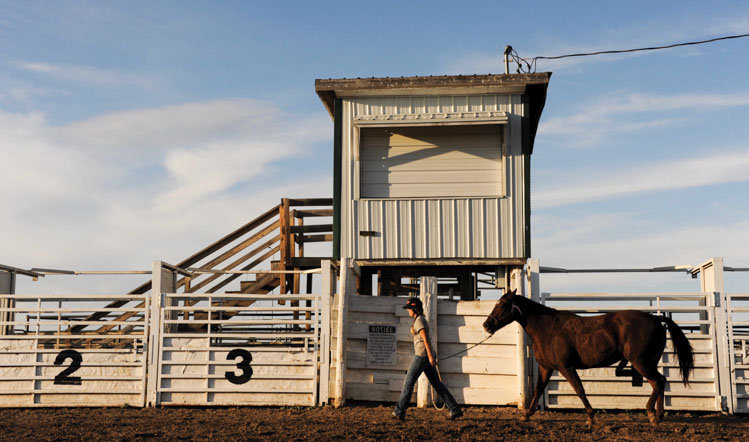 |
| Barrel racer Autumn Garcia exercises her horse, Bee, at the arena in Hermosa. |
Hermosa is Spanish for beauty, a fancy name for a working man’s town of 400 people on the eastern slope of the Black Hills where the most noticeable architectural feature is the county fairgrounds.
The town was named by railroaders who loved the mountain views to the west, as well as grassland vistas to the south, east and north. Those natural charms haven’t faded in the 134 years since the naming, and the town has developed a richness of character that now befits its name.
The natural setting has been barely compromised by commercialization and urbanization. Strip malls, office suites, corporate fast-food stops and the busy streets that connect them are 15 miles north in Rapid City, where Hermosans go to shop and where most teenagers attend high school. Hermosa’s modest business district — most of it stretching along U.S. Highway 79 — only adds to the town’s personality.
One of the Black Hills’ best-loved pizzerias is Lintz Brothers, started by Brian and Kristy Lintz in the Mount Rushmore Telephone Company building. They perfected a special crust recipe that came from Charlie Decker, an old family friend.
When the business was just beginning, a telephone work crew came to eat. “We’re hungry,” said the crew leader. “Fix us anything!”
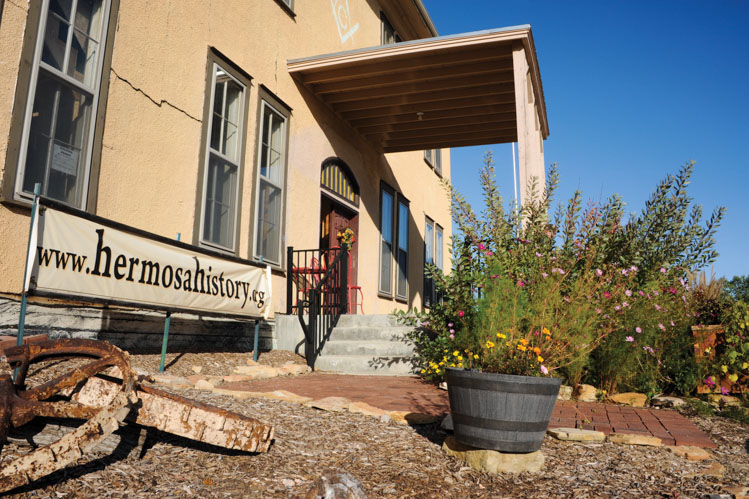 |
| An ornamental garden at the Hermosa Arts and History Association honors Doug Hesnard, a community booster who died in 2012. |
Taking that as a challenge, Lintz concocted a hearty pizza with Canadian bacon, sausage, pineapple, sauerkraut and jalapenos. He called it the Flaming German Samoan, and it quickly became a customer favorite. Other standards are the Oriental Texas Tornado and the Big Fat Greek Pizza. “We like to show people that there’s more to pizza than just pepperoni,” he says.
The pizzeria and phone company shop burned in 2015, but a new building was soon constructed for both at the juncture of Highways 79 and 36. “Today we pull 65 percent of our business out of Rapid City,” says Lintz. “It’s a nice drive on a four-lane highway and we’ve become a destination restaurant.”
Despite its close proximity to the Black Hills and Rapid City, Hermosa is not a touristy town. Still, it’s a place where you can visit any summer evening for a pizza dinner and a show because just a mile from Lintz’s is Roy’s Drive-in, which features the world’s largest movie screen. Two of them, actually.
Roy Reitenbaugh of Hot Springs started the theater in 2012, just as the movie industry was going digital. The 15-acre project became an $800,000 investment. Today, he and his daughter Correna show movies seven nights a week throughout the summer. Three hundred cars can park in front of each 80-foot digital screen.
“There used to be three outdoor theaters in Rapid City,” Reitenbaugh says. “Now there are none. We were going to put ours there but they didn’t want us. Hermosa welcomed us with open arms.”
Reitenbaugh says movie-watchers like his small-town setting. “It’s really strange, but we get people from all over. Last summer, in five days I met people from France, Finland, England, Australia and Canada.”
Hermosa has always attracted interesting and entertaining people. The musical Bower family came in the 1880s, settling near Battle Creek. Their pioneer story was told in a 1968 Disney movie titled The One and Only, Genuine, Original Family Band. Gutzon Borglum and his wife Mary moved onto a Hermosa area ranch while Gutzon blasted Mount Rushmore National Memorial from central Black Hills granite in the 1920s and ’30s.
The town still gets notable guests and residents. Successful rodeo cowboys like steer wrestler Todd Suhn, roper Jess Tierney and pick-up man Tyler Robertson have Hermosa addresses. Robertson, who was nominated as one of the PRCA’s top pick-up men in 2019, was among a group of ranchers who gave beef to the Hermosa school this year to promote the concept of local foods.
Linda Hasselstrom, one of the West’s best-known rancher/writers, lives on the family ranch south of town, where she hosts writing retreats. Hermosa is also home to Rick Mills, a historian, author and director of the South Dakota State Railroad Museum in nearby Hill City.
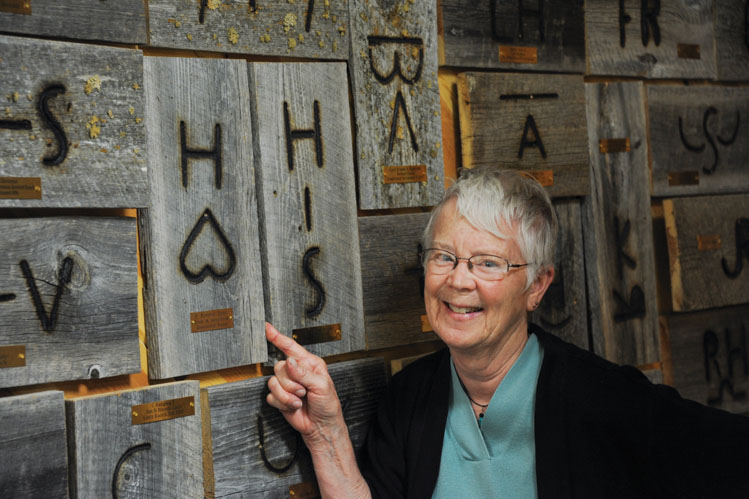 |
| The Hermosa Arts and History Association's brand exhibit features the heart-reverse-heart marking belonging to Linda Hasselstrom and her family. |
Mills says that in addition to naming Hermosa, the Fremont, Elkhorn and Missouri Valley Railroad made a decision that saved the town decades later. As the company built its rails north from Nebraska in 1885 and 1886, it decided its line would benefit by a bit more elevation over the spot where a stagecoach station sat near Battle Creek. Hermosa was platted a mile from the stagecoach stop. “That saved us twice during floods of 1972 and 2007,” Mills says. “There was never a grain elevator here, but the railroad moved a lot of beef cattle to market.”
It also moved ore — not the Black Hills’ famous gold ore, but tin from Hermosa area mines. The same year that locomotives first steamed into Hermosa, a school welcomed its first children. Today the town’s K-8 elementary school provides a small-town style of education that appeals to many parents.
Mills credits his Hermosa schooling for stoking his interest in Black Hills history. For example, in the 1970s, he and classmates rode bicycles 4 miles into the countryside to visit the Council Oak, a tree (still very much alive) that marks the site of a peace council between the Lakota people and the Utes.
A former elementary school house is still helping kids — and adults — understand local history, even though the structure was condemned 94 years ago. The big, two-story building replaced an 1886 school in 1889, served students for 27 years, then began frightening teachers and parents because of a structural problem. The building and its bell tower sometimes swayed so that the bell rang spontaneously, according to a presentation by Linda Hasselstrom in 2019, based on research by Geraldine Hesnard Evans. That prompted condemnation in 1926, but the local Masons bought the building, moved it and secured it structurally. As Hermosa’s Masonic Lodge, the transformed school hosted Masons and Eastern Star meetings, community dances and other functions. When the Masons moved into a modern hall immediately next door in 2000, the Hermosa Arts and History Association stepped in to once again transform the old school building and rebrand it as a museum, arts venue and community events center.
The history and arts group’s acronym, HAHA, hints that much of what it does is just for fun, and that there’s room for occasional levity in history. Development of the museum is ongoing but there are already items in place, including “brand boards” with brands from area ranches burned into them, and artifacts representing the Bower Family Band.
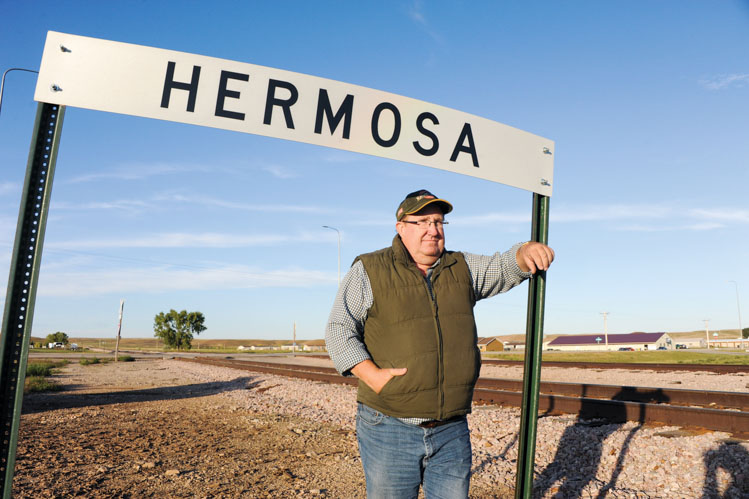 |
| Rick Mills, South Dakota's premier railroad historian, credits his passion for all things trains to his Hermosa upbringing. |
Open range cowboys who trailed cattle to the Hermosa railhead in the 1890s were key players in building the American beef industry. In 1919, with the opening of Custer State Park (a 72,000-acre wilderness that surpasses many national parks in natural splendor and outdoor recreation) Hermosa became something of an eastern gateway to the Black Hills. In fact, in 1927, when President Calvin Coolidge and First Lady Grace Coolidge made the park their summer retreat for three months, they traveled into Hermosa on Sunday mornings to attend church. That same building, today the United Church of Christ, stands just a block from the HAHA building.
Hermosa played a role in Cold War history in the early 1960s, with the installation of a Titan missile silo 5 miles south of town. Ellsworth Air Force Base crews staffed it. Today, the missiles and soldiers are gone but it’s easy to find the site because Missile Road is more nicely paved than most country roads in Custer County.
Nineteenth-century weaponry can be found at Highland Park Cemetery on the west edge of town. Two cannons that stood on the Dry Tortugas — an archipelago of small islands several sea miles west of Key West, Florida — now point toward Hermosa. The Dry Tortugas were ideal for housing dangerous criminals, including Dr. Samuel Mudd, who was accused of aiding President Abraham Lincoln’s assassin, John Wilkes Booth. Apparently, the cannons were positioned within view of Mudd’s cell. In 1901 the federal government gifted the cannons to Hermosa’s William Stanley, a Union Civil War veteran. Stanley was highly regarded for organizing posts of the Grand Army of the Republic, a fraternity of former Civil War soldiers, across South Dakota.
Highland Park Cemetery is aptly named; the gravestones sit on a rise that offers a wide vista of the Black Hills’ front range. It is the final resting place for 23 Civil War veterans, Union and Confederate alike. That surprises people because the war was fought a decade before white settlement in the Black Hills. The veterans’ graves are testimony to how many ex-soldiers were motivated to escape the blood-stained East and South for the cattle trails, gold fields and homesteads of the West.
There’s a quieter form of history, significant in its own right, that Linda Hasselstrom wants to see archived at the HAHA museum. In town, and on far-flung ranches and farms, many people kept journals that documented daily life — weather, wildfires, agricultural yields, and family joys and heartaches. “We’re finding people we had no idea might be journaling were doing so for years,” she says. “Many were women, and it’s good to gain those points of view.”
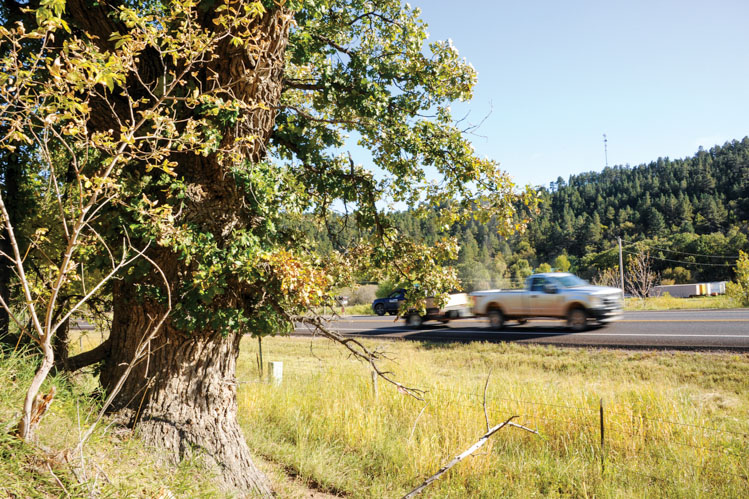 |
| A historic tree called the Council Oak grows in a ditch along Highway 40 west of Hermosa. The tree, estimated to be 400 years old, was a gathering place for Native American tribes. |
Mills believes a pride in local heritage has served Hermosa well. He points to the town’s 1986 centennial celebration that brought about HAHA, and says the event spurred regional attention about what makes Hermosa unique. It’s probably no coincidence that the centennial marked the approximate beginning of young families moving in — enough to trigger a school enrollment boom. Lintz, the pizzeria owner, says it’s possible that continued population growth could even lead to a new high school.
His family has ranched and run businesses in the area for 120 years. “There’s a strong sense of community here, and the people that move in here seem to appreciate that,” he says. “It’s nice to see the growth, and yet we’ve maintained the feeling of a small town.”
Hermosa is not for everyone; it’s a town for those who love the idea of seeing their kids immersed in nature regularly, signed up for 4-H and learning to ride and rope at the big arena just east of the railroad tracks on the Custer County Fairgrounds. Hermosa seems to suit South Dakotans who want to be close to urban amenities, and perhaps even the business and career opportunities, of Rapid City but who also like to escape the claustrophobia of highways, high-rises and even high mountains.
Gates swing two ways. Hermosa is not only a gateway to the Black Hills, but also to South Dakota’s wide-open spaces.
Editor’s Note: This story is revised from the January/February 2020 issue of South Dakota Magazine. To order a copy or to subscribe, call (800) 456-5117.



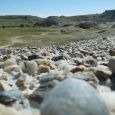

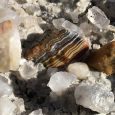

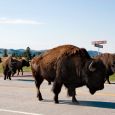


Comments